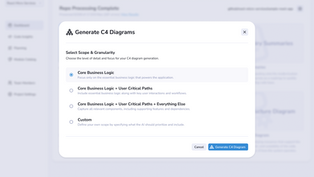AI Reverse Engineering Tool
Project Overview
The Code2Spec platform leverages advanced AI processing pipelines built around OpenAI to analyze legacy codebases and reverse engineer business requirements. This innovative solution aims to help organizations modernize outdated systems by automatically uncovering the "why" behind the code - accelerating digital transformation with deep, contextual understanding.
The Challenge
Enterprises often rely on large, outdated codebases with minimal documentation. Replacing or updating these systems is risky and expensive due to the difficulty of understanding the embedded business logic.
Our mission:
How might we design a platform that makes it easy for developers, analysts, and product teams to explore legacy code and extract meaningful, actionable business requirements - without needing to manually trace every line.
My Role
My role as Principal UX Designer was to lead interaction design from problem definition through to a scalable solution. My approach combined deep hands-on design craft with a strategic lens - ensuring what we build not only solves today’s problem but fits into a broader product vision.
During the project, I led the end-to-end design and research strategy. I worked closely with stakeholders, product managers, and engineers to shape a clear vision for the product and ensure usability remained central to every decision.
I defined common interaction patterns, accessibility standards, and reusable code-ready components, partnering closely with engineering to embed these into design systems. This ensured consistency, reduced design and development time, and created a shared language across teams.
As a design leader, I guided teams in making evidence-based design decisions while also articulating the “big picture” vision - so our immediate iterations ladder up to a cohesive, long-term product strategy. I mentored designers on both craft and systems thinking, helping them see the impact of their work at both micro-interaction and platform-wide levels.
-
Interaction Design Leadership – Led cross-functional design initiatives from research analysis to high-fidelity, code-ready prototypes.
-
Strategic Vision Setting – Defined long-term UX vision and design principles that guided product evolution.
-
Design System Stewardship – Established shared component libraries, interaction standards, and documentation to scale design consistency.
-
Collaboration with Engineering – Built design-to-code pipelines ensuring pixel-perfect, accessible, and maintainable implementation.
The Research
This phase was crucial in defining the core value proposition of the product, identifying the target audience and understanding the problem it solves.
Problem Statement
How might we solve the issues faced by modernization teams with our AI platform?
In the beginning, we assumed a product team would largely be responsible for this part of the work and targeted our research towards this persona. Early on in the interviews however, it became very clear we needed to pivot towards the developer and therefore shifted our research to interview engineers, specifically ones working on modernization projects with legacy systems, usually involving COBOL (banking, insurance etc) and highly sensitive data
Target Persona
Emilio Holiday is a senior software engineer, leading a team of developers who are all well versed in modern technologies and expert at writing efficient code.
The company that hired them has a 30 year old mainframe system that needs to modernize so they can continue to provide the same services to their clients without disruption.

Research Methods
-
15 mainframe developer interviews.
-
8 mainframe research papers.
-
3 surveys to mainframe teams.
Key Research Findings
-
Due to security risks, companies are preferring to keep sensitive data on their mainframes and modernize systems into the cloud like analytics and reporting.
-
Attempting large scale migration without fully understanding workload interdependencies or time and budget needs has led many to underestimate the impact of modernization and project failure.
-
Legacy applications are not designed to support continuous delivery, as some components within these applications create obstacles - or friction points - that negatively impact business operations.
-
Poor coordination between product and modernization teams - and lack of engagement with business leaders - will undermine continuous modernization efforts.
-
Main reasons to spend money on a modernization project: license costs, lack of scalability, stability and performance, customer complaints, security issues, industry competition and a desire for greener industry.
-
Problems faced by modernization teams: dead code, difficult to understand systems and business logic, lack of documentation, outdated processes and tools.
-
By prioritizing the mainframe developer experience and automating manual activities organizations can deliver even greater value to their businesses.
Brainstorming
We analyzed interview data in Dovetail, using tags aligned with our research script to surface key themes and insights.
Affinity Mapping
Click to enlarge (note that team comments have been removed)
To synthesize the raw data and get a better picture of problem areas, I facilitated a workshop using Miro to create an affinity map and group user feedback, pain points and behaviours to find patterns. Using sticky notes, the team grouped related ideas. This helped us identify recurring issues and unmet user needs that informed feature priorities.
Participants were: design, product and engineering.

User Journey Map
Click to enlarge (note that team comments have been removed)
I facilitated this workshop using Miro to analyze the research findings. The team mapped pain points and opportunities in a Miro experience map to visualize the user journey pain points and opportunities.
Once complete, we presented our findings to stakeholders, including key takeaways from the research reports.
Participants were: design, product, engineering, sales.

The Design
User Flows
Click to enlarge (note that team comments have been removed)
Working closely with the Senior Designer and Director of Product, we translated the research insights into user flows using Figma that balanced user needs with business goals, and allowed us to design the logical flow. This gave us a strong foundation to begin concepting our solution and prioritizing the features for our roadmap.
Participants were: design, product and engineering.

Figma Prototype
Click to enlarge
After some initial testing with low fidelity wireframes where we defined the structure, layout and flow, we moved to a higher fidelity prototype.
Using components and the color scheme from our design system, I created a prototype using Figma to make the user testing as real as possible. The user testing results provided us with valuable insights into the features we'd designed for. We ended up removing some of the less useful data points, simplifying the solution into 3 main diagrams for an MVP release that would illustrate the code and highlight issues for the developer.
Figma Interactions
Click to enlarge
Included in this screen shot are the interactions shown in Prototype Mode in Figma. They illustrate the interactions including triggers and navigation type designed to make this prototype feel as real as possible. The design system provides variants of each component used to design such things as button states etc.
This was very helpful in testing the interactions and communicating intent to stakeholders and engineers. It bridges the gap between static design and live experience and ensures the design is easy to understand.

Final Design
Next Steps
Product, engineering and design had planning sessions around the work to be done, splitting it into 4 stages to be completed over an 8 month period, in 2 week sprints. We had a demo at the end of each sprint to show progress and gather feedback.
The System Diagrams were complex, so a front end developer worked on those in parallel to the rest of the platform. Feedback from engineers during the coding phase was essential for success, and allowed us to identify several edge cases we’d missed.
The rest of the data points were used in the product side of the platform targeted for a later release, to show a Product Requirements Document of features, their priority, code snippets and a module library along with AI peppered throughout to provide suggestions and allow the user to provide context to the solution to customize the outcome.
After successful release the plan is to add to code insights, bringing more value to the user and implement some of the other thoughts from our user interviews.
Outcomes & Impact
-
Reduced time spent interpreting legacy code by over 60%, based on early pilot feedback.
-
Helped define key product differentiators (e.g., traceable AI reasoning, requirements tagging).
-
Created a scalable design language and research ops toolkit for the broader product team.
-
Enabled stakeholders to make confident, strategic decisions by exposing hidden logic within their systems.


Reflection
This project reinforced the importance of designing with both technical depth and clarity, especially when integrating AI into highly specialized workflows. By blending user research, systems thinking, and tight collaboration with engineering, we were able to deliver a product that’s not just smart - but usable and trusted.












